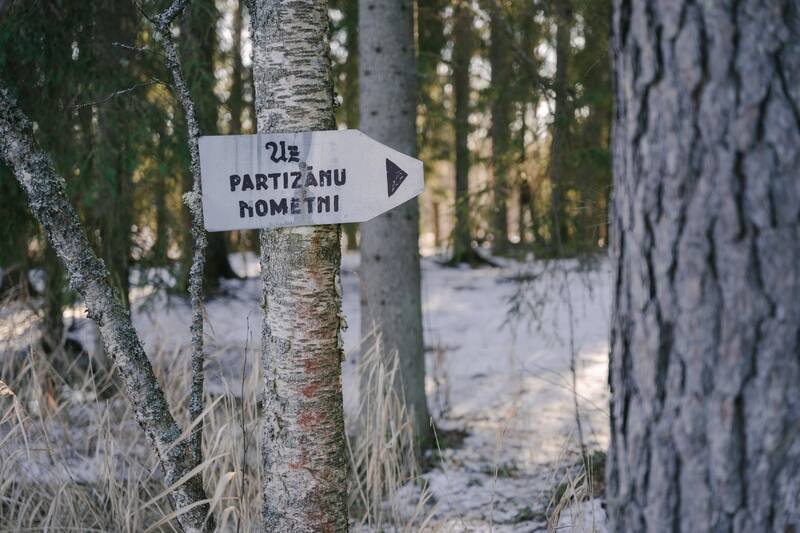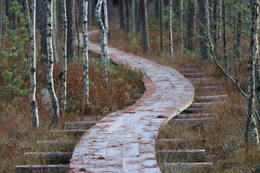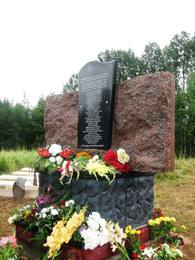Audio Guide
National Partisans in the Stompaki Swamp

During WWII, Stompaki swamp was one of the largest national partisan camps in the Baltics, with 24 bunkers and several surface buildings. The Stompaki battle took place here on March 2, 1945, a major clash between partisans and Soviet forces.
You can view this guide online by visiting the following page:
Visit the GuideRelated timeline
Related objects
Trail and partisan memorial in Stompaki bog
During World War II, one of the largest national partisan camps in the Baltic states was situated in Stompaki Swamp. Today, the territory is included in the nature reserve “Stompaki swamp”. The settlement sites located on the islands in the swamp can be reached via a marked footpath.
In early 1945, about 350 to 360 people, including 40 to 50 women, lived at the camp of National Partisans in Stompaki Swamp. The camp consisted of 24 residential bunkers – buildings that were half-immersed into the ground and could accommodate 3–8 people. There was a bakery, a church bunker and three above-ground rails for horses. Partisans from the camp carried out attacks against officials of the occupation regime. On 2–3 March 1945, the Battle of Stompaki took place here – the largest battle in the history of Latvian national partisans. The 350–360 partisans in the camp were attacked by the 143rd Rifle Regiment of NKVD and local fighters of the so-called ‘istrebitel’ (eliminators) battalion – 483 men in total. The battle lasted for the entire duration of the day on 2 March. On the night of 3 March, the partisans managed to break out of the camp and retreat to their previous base camps. The battle resulted in 28 casualties among partisans, while the NKVD force lost 32 fighters.
Today, the site of the Stompaki camp is home to three restored bunkers – a church, a headquarters and a residential bunker – as well as 21 sites of former bunkers. Information boards about the camp and the battle have been installed at the site. Guided tours can be booked.
Monument to the participants of the resistance movement in Stompaki
Located 15 km from Balvi in the direction of Viļaka, on the right side of the road.
A memorial sign is visible.
A memorial to the participants of the resistance movement, dedicated to the memory of the national partisans of Pēteris Supe who fell in the battles of March 2 and 3, 1945, was unveiled on the side of the Balvu - Viļakas highway opposite the Stompaku swamp on August 11, 2011, on the Day of Remembrance of Latvian Freedom Fighters. At the end of July, a capsule with a message for future generations was embedded in the foundation of the monument. A document with the names of 28 national partisans who fell in the battles of March 2 and 3, 1945 is placed in the capsule.
"In February 1945, on the islands of the Stompaku swamp, which the people began to call the Stompaku swamp islets, 2 km from the Balvi - Viļaka highway, the largest national partisan camp in Latvia was established, where 360 people lived in 22 dugouts. Among them were some legionnaires who, when the legion division retreated, had remained at their father's house with all their weapons. In order to destroy the partisans, on March 2, 1945, soldiers from two Cheka battalions attacked the dugouts together with destroyers, who also had four mortars in their armament. The fighting lasted all day, the partisans resisted stubbornly, and the attackers suffered heavy losses, so that they were unable to take the camp and destroy the partisans. 28 residents of the Stompaku swamp had also fallen in the battle or died from serious injuries. The next night, the partisans broke through the camps with a battle "the siege and left undefeated" - this is what Zigfrīds Berķis, the chairman of the Commission for the Affairs of the National Resistance Movement Participants of the Awards Department, writes about the Battle of Stompak.





